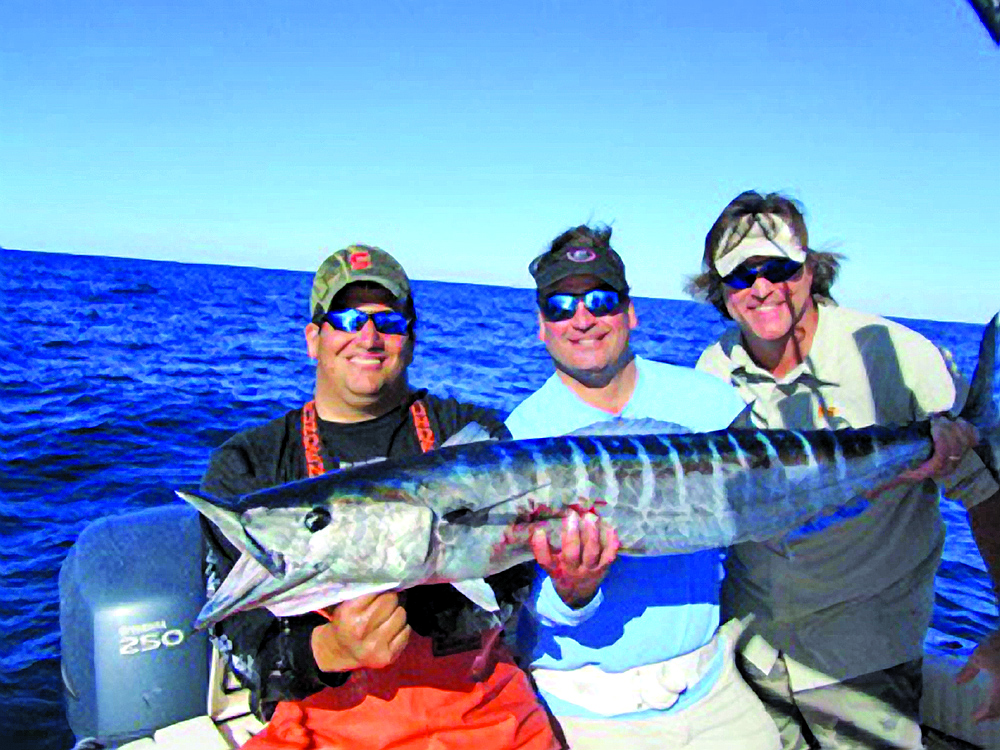High Speed Trolling
February marks a time when weather patterns can be unpredictable. Low pressure and cold fronts push through, creating wet conditions for several days, followed by high pressure and high winds.
These conditions, along with dense fog, are common during this time of the year making it difficult to safely make the long 60+ mile run to the gulf stream and back. But occasionally Mother Nature will give you a narrow window of a day or two. When seas calm, it is time to get out and chase wahoo.
In years past, artificial and dead bait (ballyhoo) would be pulled at a slow pace of 6 to 7 knots in search of these pelagic species. But there has been a recent shift away from this method by some anglers.
The method that has become popular is high speed trolling. This is when anglers troll artificial lures at higher speeds between 12 to 18 knots (or even faster). Wahoo are some of the fastest fish in the ocean swimming at speeds of up to 60 mph, so these high speeds do not deter bites when you find the fish.
One reason some anglers prefer higher speeds over slower speeds is it allows the angler to cover more ground more quickly in search of sea-surface temperature breaks and schooling fish. Watching your depth and running zigzag patterns over the ledge can be a great way to target these fish.
The tackle for high speed trolling is very important to ensure success.
The 60 to 80 lb. mono main line (120 lb. + braid line can also be used) attaches to a trolling weight of 24, 36 or 48 ounces with a snap swivel. Trolling weights are used because pulling lures at these speeds would cause the lure to skip across the surface. The weights keep the lures running below the surface. The trolling weights have short steel cables on each end to ensure an accidental bite from a wahoo does not break the entire rig off.
The trolling weight connects to a 300 lb. mono shock leader of 25 to 30 feet in length. This ensures the pressure of a striking fish is absorbed by the large leader, and not solely on the lighter 60 to 80 lb. main line, potentially breaking the main line.
The shock leader attaches to a 5 to 6 foot steel cable which hosts your artificial lure designed specifically for high speed trolling.
As for your reels, the pressure due to the high trolling speeds and weight of the rigs will be very demanding on the drag. Offshore 50s are equipped with heavy drag capability and will have plenty of main line capacity which will be needed with the larger fish.
Putting the lines out requires some precision. The longest lines with the lighter trolling weights (24 ounces) need to be put out first and the shortest lines with the heavier weights (48 ounces) will be put out last. No two lines should be put out at the same length. With all lines set at different lengths, and the heavier trolling weights in close, this will help ensure the shorter lines with heavier trolling weights run under the longer lines with lighter weights when the captain is making slight turns. Running the longer lines using outriggers and tag lines will help keep the lines separate as well. Tag lines are important and are designed to bear the brunt of the pressure of high speed trolling so your outriggers do not. You could damage your outriggers without the use of tag lines.
High speed lures come in different sizes. Make sure you set the larger lures in close. The disturbed water from the prop wash directly behind the boat will make smaller lures harder for the fish to see. Run the smaller lures further back where the water is less disturbed.
Once all the lines are out, make sure the clickers on all the reels are set. With the trolling speeds and the pressure of a 40+ lb. fish strike, line will scream off the reel for a few minutes. The clickers will ensure you hear this without unknowingly losing all of your main line from the initial strike.
When the strike comes, mark your position on your chart plotter. You may have run through an area of good water temperature and there may be more fish to target once you land this one. Also, keep the boat speed and the direction the same for a minute. If you ran through multiple fish, keeping the boat running the same speed will increase your chances of multiple hook-ups.
Once you are ready to fight this fish, slow down but keep the boat in gear making sure you always maintain pressure on the fish. Slowing the boat too much may introduce slack in the line, allowing the fish to turn and throw the hook.
Once the wahoo is boat side and the fish is ready to gaff, make sure all anglers are clear from the deck when the gaffer brings the fish on board. High speed lures are equipped with multiple hooks that can be very dangerous to anglers when swinging around from an angry fish. And with a movable upper jaw, a wahoo’s mouths hinges like a pair of scissors and can cut or tear with ease. Wahoo have been known to take a bite out of seat vinyl or flesh, so it is important that the gaffer controls the fish and everyone is out of the way.
Once the fish is under control, let the pictures begin.







